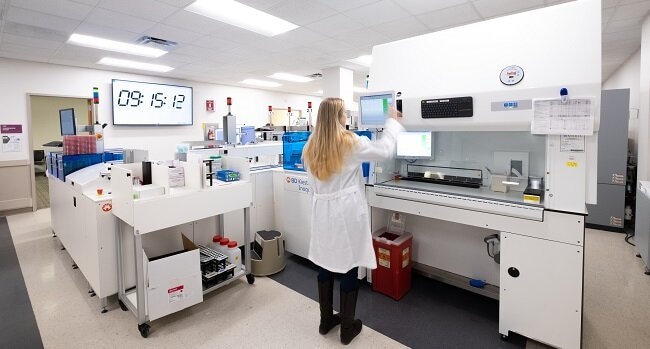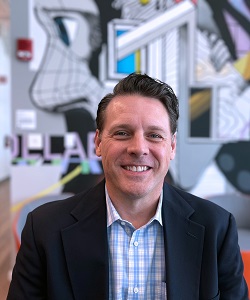As artificial intelligence (AI) becomes more ingrained in the healthcare experience, health facilities have an opportunity to reinvent themselves. Services traditionally performed at acute care sites using processes requiring hours or days to determine a diagnosis are available at outpatient facilities with greater accuracy and a quicker turnaround. This provides a better patient experience and lower facility overhead costs. The environments where this partnership between humans and technology exists are evolving and will likely become more than places for just curing the sick, but rather places of good health.
Types of AI in healthcare
Two categories of AI—visual AI and physical AI—have the most meaningful effect on clinical workflow, and it is essential to understand the difference between them: Visual AI handles tasks involving data management, like electronic health records (EHRs), scheduling, and tracking physical health. It can combine several technologies, such as computer vision, natural language processing (NLP), various content formats like video and photos, and deep learning, to enable machines to identify, understand, and act on imagery and visual data. And, since AI can quickly manage large volumes of data, repetitive tasks can be done faster while prioritizing items that might require staff intervention.
Physical AI relies on AI techniques to “solve problems that involve direct interaction with the physical world.” Physical AI assists staff with tasks that operate a physical mechanism, such as a surgical arm or pharmacy dispensing machine. This replaces or augments an activity previously performed by human hands. As processes people traditionally perform rely less on physical spaces, particularly in support roles, more space can be designed as clinical or wellness areas that could improve the patient and staff experience and the facility’s efficiency.
Weighing the benefits of AI in healthcare
Incorporating AI can improve the overall patient experience from both a workflow and treatment standpoint. Provider interaction time can be increased, and more accurate treatment plans can be defined. The new experience makes patients the center of the visit while delivering better outcomes. The methods of incorporating AI into a facility can vary and are vital in improving patients’ perceptions of AI use in treatment and care management. Ideally, patients should be unaware of AI’s involvement in their care. A seamless integration supports the care team so more time can be spent with the patient, and successful treatment plans can be defined quickly. This will create an experience focused on personalized care.
Input from the healthcare professionals who provide care is crucial to designing healthcare facilities that enable smooth AI integration. As the coronavirus pandemic proved, even the best, most dedicated healthcare workers have their limits, with stress levels and mental health concerns skyrocketing throughout the pandemic and the industry seeing burnout and job-related stress driving high turnover. Reducing the demands on clinicians and support staff, especially freeing them from repetitive and redundant tasks, creates a healthier work environment that reduces stress and fatigue. Engaged and energized employees make fewer mistakes, which naturally improves the care experience for all involved.

Challenges to consider
There are challenges and potential drawbacks associated with AI implementation in healthcare organizations. Consider a 2021 study in which the authors noted that “artificial intelligence has the potential to make substantial progress toward the goal of making healthcare more personalized, predictive, preventative, and interactive” while indicating that AI-based technologies raise concerns around data security and privacy, for instance.
“Because health records are important and vulnerable, hackers often target them during data breaches,” the study authors continued. “The absence of standard guidelines for the moral use of AI and ML [machine learning] in healthcare has only served to worsen the situation. There is debate about how far artificial intelligence may be utilized ethically in healthcare settings, since there are no universal guidelines for its use.”
Indeed, no such guardrails currently exist, which leaves healthcare institutions to ensure AI is used responsibly and ethically within their organizations. As patient records become more connected and accessible to AI, the ethics of consent and regulation of that data become more complex. Large data sets are essential to the accuracy of machine learning, but transparency of the data’s use and access limitations will be critical. Attaining a balance between privacy and access is paramount.
Trust concerns can also arise, and there have already been instances in which AI was introduced into the clinical workflow with mixed reviews. In June 2021, for example, The Journal of the American Medical Association (JAMA) published an examination of patient data from Michigan Medical to determine the accuracy of the Epic Sepsis Model in predicting sepsis in hospital patients. According to JAMA, the algorithm’s accuracy in identifying patients with sepsis was only 33 percent. It failed to identify 67 percent of patients with sepsis. As algorithms are adjusted and the data sets from which AI learns continue to grow, it is imperative that accuracy in AI recommendations increases to earn the healthcare industry’s trust.
As with any new practice, process, or technology, there will also be resistance to change as AI proliferates in the healthcare industry and worldwide. One recent study found that 77 percent of 2,000 employed Americans expressed concern that AI would cause job loss within the next 12 months. Among this group, nearly 45 percent said they were “very concerned,” with another 33 percent feeling “somewhat concerned” about AI-related job loss in that same timeframe. Those worries and the reluctance to embrace AI exist in healthcare as well. Whether rooted in traditional methods or the fear of being replaced by machines, most facilities are not ready to embrace the workflow changes needed to reap the benefits of AI.
AI at work in healthcare settings
AI-powered patient scheduling has also been shown to aid providers at renowned healthcare institutions such as the Cleveland Clinic, where an AI-driven tool known as the Virtual Command Center provides staff with “a real-time look at OR scheduling opportunities and patterns of use” and “can also help with case-prediction analyses and PACU-capacity estimates as well as suggest actions to optimize OR resources,” according to the Cleveland Clinic.
Several other healthcare innovations leverage AI, such as telemedicine. Of course, the use of telehealth skyrocketed during the coronavirus pandemic, and many physicians and facilities plan to continue relying on it. AI can aid telemedicine in many ways, assisting patient remote monitoring, improving patient diagnosis accuracy, and personalizing patient treatment plans.
Recent research suggests that AI improves physician-patient communication as well. “We are very interested in using AI to help solve health system challenges, including the increase in patient messages that are contributing to physician burnout,” said Christopher Longhurst, MD, executive director of the Joan and Irwin Jacobs Center for Health Innovation, chief medical officer and chief digital officer at UC San Diego Health, and senior author of a 2024 study evaluating AI-drafted physician messaging. “The evidence that the messages are longer suggests that they are higher quality, and the data is clear that physicians appreciated the help, which lowered cognitive burden,” according to Longhurst.
Balancing technology with patient-centric care
Ultimately, technology such as AI is valuable in the healthcare system, but proper application is critical. AI can help shape the facility, but its human counterparts are the stars. As AI fills a more prominent healthcare role and begins to shape facilities physically, it’s crucial to balance the desire to improve efficiency with maintaining patient and staff interactions.

In the end, AI is here and will continue to impact a more significant share of the healthcare industry. And, as with all new technology, AI tools require understanding their capabilities and limitations. Whether AI is being used to communicate test results to a patient or help an endoscopy physician identify polyps, it is imperative for staff to integrate it into the clinical workflow. There is better coordination with the care team by understanding AI’s role. Recognizing AI’s opportunities and limitations quickly is critical for it to be a trusted partner in the healthcare experience.


















